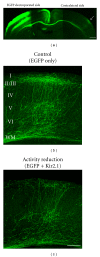Activity-dependent callosal axon projections in neonatal mouse cerebral cortex
- PMID: 23213574
- PMCID: PMC3507157
- DOI: 10.1155/2012/797295
Activity-dependent callosal axon projections in neonatal mouse cerebral cortex
Abstract
Callosal axon projections are among the major long-range axonal projections in the mammalian brain. They are formed during the prenatal and early postnatal periods in the mouse, and their development relies on both activity-independent and -dependent mechanisms. In this paper, we review recent findings about the roles of neuronal activity in callosal axon projections. In addition to the well-documented role of sensory-driven neuronal activity, recent studies using in utero electroporation demonstrated an essential role of spontaneous neuronal activity generated in neonatal cortical circuits. Both presynaptic and postsynaptic neuronal activities are critically involved in the axon development. Studies have begun to reveal intracellular signaling pathway which works downstream of neuronal activity. We also review several distinct patterns of neuronal activity observed in the developing cerebral cortex, which might play roles in activity-dependent circuit construction. Such neuronal activity during the neonatal period can be disrupted by genetic factors, such as mutations in ion channels. It has been speculated that abnormal activity caused by such factors may affect activity-dependent circuit construction, leading to some developmental disorders. We discuss a possibility that genetic mutation in ion channels may impair callosal axon projections through an activity-dependent mechanism.
Figures



Similar articles
-
Activity-dependent development of callosal projections in the somatosensory cortex.J Neurosci. 2007 Oct 17;27(42):11334-42. doi: 10.1523/JNEUROSCI.3380-07.2007. J Neurosci. 2007. PMID: 17942728 Free PMC article.
-
Pre-synaptic and post-synaptic neuronal activity supports the axon development of callosal projection neurons during different post-natal periods in the mouse cerebral cortex.Eur J Neurosci. 2010 Feb;31(3):410-24. doi: 10.1111/j.1460-9568.2009.07070.x. Epub 2010 Jan 25. Eur J Neurosci. 2010. PMID: 20105242
-
NMDA receptors control development of somatosensory callosal axonal projections.Elife. 2021 Mar 4;10:e59612. doi: 10.7554/eLife.59612. Elife. 2021. PMID: 33661095 Free PMC article.
-
Activity-dependent development of interhemispheric connections in the visual cortex.Rev Neurosci. 2008;19(1):19-28. doi: 10.1515/revneuro.2008.19.1.19. Rev Neurosci. 2008. PMID: 18561818 Review.
-
Axon guidance mechanisms for establishment of callosal connections.Neural Plast. 2013;2013:149060. doi: 10.1155/2013/149060. Epub 2013 Feb 24. Neural Plast. 2013. PMID: 23533817 Free PMC article. Review.
Cited by
-
Dynamic synchronization of ongoing neuronal activity across spinal segments regulates sensory information flow.J Physiol. 2015 May 15;593(10):2343-63. doi: 10.1113/jphysiol.2014.288134. Epub 2015 Mar 17. J Physiol. 2015. PMID: 25653206 Free PMC article.
-
Reduction of corpus callosum activity during whisking leads to interhemispheric decorrelation.Nat Commun. 2021 Jul 2;12(1):4095. doi: 10.1038/s41467-021-24310-6. Nat Commun. 2021. PMID: 34215734 Free PMC article.
-
Disrupted Excitatory Synaptic Contacts and Altered Neuronal Network Activity Underpins the Neurological Phenotype in PCDH19-Clustering Epilepsy (PCDH19-CE).Mol Neurobiol. 2021 May;58(5):2005-2018. doi: 10.1007/s12035-020-02242-4. Epub 2021 Jan 7. Mol Neurobiol. 2021. PMID: 33411240
-
Myosin X Interaction with KIF13B, a Crucial Pathway for Netrin-1-Induced Axonal Development.J Neurosci. 2020 Nov 25;40(48):9169-9185. doi: 10.1523/JNEUROSCI.0929-20.2020. Epub 2020 Oct 23. J Neurosci. 2020. PMID: 33097641 Free PMC article.
-
Developmental stage-specific spontaneous activity contributes to callosal axon projections.Elife. 2022 Aug 24;11:e72435. doi: 10.7554/eLife.72435. Elife. 2022. PMID: 36001081 Free PMC article.
References
-
- Hubel D, Wiesel T. Cortical and callosal connections concerned with the vertical meridian of visual fields in the cat. Journal of Neurophysiology. 1967;30(6):1561–1573. - PubMed
-
- Shatz CJ. Anatomy of interhemispheric connections in the visual system of Boston Siamese and ordinary cats. Journal of Comparative Neurology. 1977;173(3):497–518. - PubMed
-
- Olavarria J, Montero VM. Relation of callosal and striate-extrastriate cortical connections in the rat: morphological definition of extrastriate visual areas. Experimental Brain Research. 1984;54(2):240–252. - PubMed

